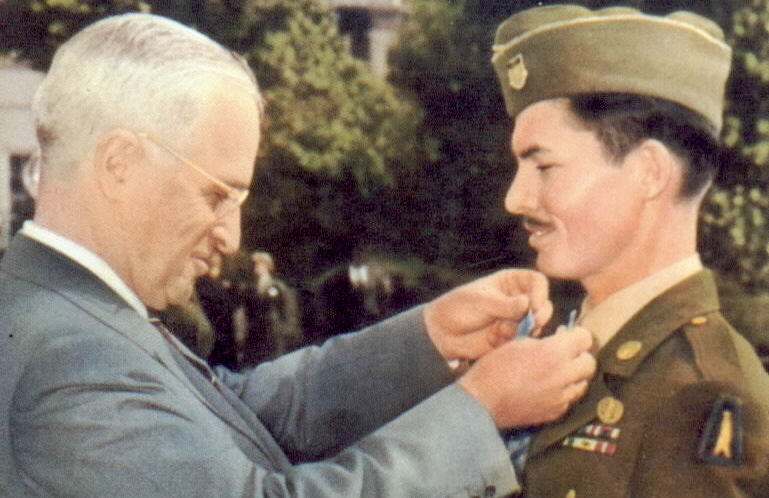(Video above: A preview of “Hackshaw Ridge.”)
If you were asked to list the bare necessities needed to march into battle during a World War, a gun would no doubt be among the first items listed.
But for Desmond T. Doss, that was the one item he could not use. His faith as a Seventh-day Adventist wouldn’t allow it. But in 1942, in the wake of the Pearl Harbor attack and the United States’ entry into World War II, Doss also could not sit idly by and allow thousands of his countrymen to go fight the war on his behalf.
So he did the unthinkable: He volunteered to go to war without a weapon, with the self-imposed mission of saving as many lives as possible.
Some of his fellow soldiers mistook his anti-violence beliefs as cowardice, until they found themselves in the midst of one of the most intense battles of the war.
What happened next is considered one of the most heroic acts of bravery in American history, and ultimately made then-Private First Class Doss the first conscientious objector to receive the Medal of Honor.
His Medal Of Honor citation explains:
He was a company aid man when the 1st Battalion assaulted a jagged escarpment 400 feet high. As our troops gained the summit, a heavy concentration of artillery, mortar and machinegun fire crashed into them, inflicting approximately 75 casualties and driving the others back. Pfc. Doss refused to seek cover and remained in the fire-swept area with the many stricken, carrying all 75 casualties one-by-one to the edge of the escarpment and there lowering them on a rope-supported litter down the face of a cliff to friendly hands.
On May 2, he exposed himself to heavy rifle and mortar fire in rescuing a wounded man 200 yards forward of the lines on the same escarpment; and 2 days later he treated 4 men who had been cut down while assaulting a strongly defended cave, advancing through a shower of grenades to within eight yards of enemy forces in a cave’s mouth, where he dressed his comrades’ wounds before making 4 separate trips under fire to evacuate them to safety.
On May 5, he unhesitatingly braved enemy shelling and small arms fire to assist an artillery officer. He applied bandages, moved his patient to a spot that offered protection from small arms fire and, while artillery and mortar shells fell close by, painstakingly administered plasma.
Later that day, when an American was severely wounded by fire from a cave, Pfc. Doss crawled to him where he had fallen 25 feet from the enemy position, rendered aid, and carried him 100 yards to safety while continually exposed to enemy fire.
On May 21, in a night attack on high ground near Shuri, he remained in exposed territory while the rest of his company took cover, fearlessly risking the chance that he would be mistaken for an infiltrating Japanese and giving aid to the injured until he was himself seriously wounded in the legs by the explosion of a grenade. Rather than call another aid man from cover, he cared for his own injuries and waited 5 hours before litter bearers reached him and started carrying him to cover. The trio was caught in an enemy tank attack and Pfc. Doss, seeing a more critically wounded man nearby, crawled off the litter; and directed the bearers to give their first attention to the other man.
Awaiting the litter bearers’ return, he was again struck, by a sniper bullet while being carried off the field by a comrade, this time suffering a compound fracture of 1 arm. With magnificent fortitude he bound a rifle stock to his shattered arm as a splint and then crawled 300 yards over rough terrain to the aid station.
Through his outstanding bravery and unflinching determination in the face of desperately dangerous conditions Pfc. Doss saved the lives of many soldiers. His name became a symbol throughout the 77th Infantry Division for outstanding gallantry far above and beyond the call of duty.
Corporal Doss survived the war, but shortly thereafter was diagnosed with tuberculosis, which cost him a lung. He lived in Piedmont, Alabama, until his death in 2006.
But this year, 10 years after he passed away and 70 years after President Harry Truman hung the Medal of Honor around his neck for the first time, the whole world is about to be reminded of his story.
This November, a star-studded feature film named “Hacksaw Ridge” will detail Doss’s heroic exploits in theaters around the world.
Mel Gibson directed the movie and Andrew Garfield will play Doss.
Here’s how Lionsgate Movies describes the film:
Hacksaw Ridge is the extraordinary true story of Desmond Doss who, in Okinawa during the bloodiest battle of WWII, saved 75 men without firing or carrying a gun. He was the only American soldier in WWII to fight on the front lines without a weapon, as he believed that while the war was justified, killing was nevertheless wrong. As an army medic, he single-handedly evacuated the wounded from behind enemy lines, braved fire while tending to soldiers and was wounded by a grenade and hit by snipers. Doss was the first conscientious objector awarded the Congressional Medal of Honor.
The first preview for the movie can be viewed above. If it is any indication, it looks like they’ve done Doss’s incredible story justice.

Don’t miss out! Subscribe today to have Alabama’s leading headlines delivered to your inbox.
